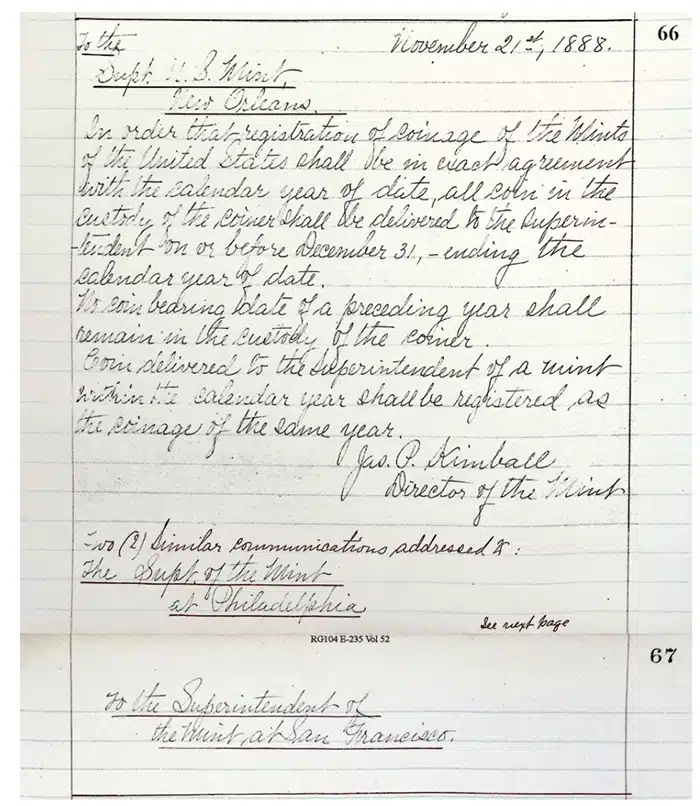By Roger W. Burdette, special to CoinWeek …..
We like to assume that all coins with the current year’s date were delivered to the Treasurer (or Cashier, beginning in 1873) of the United States Mint in the same year. This implies that any coins delivered on January 2 of the next year all carried that new year’s date. However, this was not always the case.
A common source of inaccuracy in coin mintage was the practice of the Coiner delivering coins struck the previous calendar year during the following year. With production accounts based on delivery date and not manufacture date, it meant that a report for January 1880 might actually include thousands of pieces struck and dated “1879” but not physically delivered until 1880. Obviously, this could produce annual mintage data that were incorrect.
The early Philadelphia Mint struck silver and gold coins on demand from bullion depositors, and produced cents and half cents on the Mint’s own account. Under normal operation, coins were struck using available dies. In most situations, these were dies whose date was the same as the year of manufacture.
But many times, particularly in the first two decades, dies from the previous year were used until they were worn out or newly dated versions were available from the Coining Department. Working dies were also comparatively expensive to make, and many were ruined during annealing and tempering. To fill the need for dies, usable old ones were put into service, and antedated dies were repunched with a new date and then used until they failed.
The situation had been officially noted on occasion (ever since the earliest years of the Philadelphia Mint), but nothing had been done. Inaction might have been encouraged by the Federal Government’s fiscal year beginning on a different date than the calendar year (the fiscal year began April 1, later moved to July 1, and eventually began on October 1). At the branch mints, their annual settlement–which entailed a full stop of coinage work–coincided with the fiscal year, not the calendar year. When work restarted it was the same calendar year, so coin dates remained unchanged. Therefore, it didn’t matter whether coins were delivered before or after annual settlement.
Coins were occasionally made near the end of one year and delivered in the new year without distinction of date. Prior to 1873, if a large deposit were made near the end of a calendar year, some of the coins might have been struck with the deposit year’s date and not delivered until January or even February of the following year. A common situation both before and after 1873 was when coins were struck late in December – such as the 29th through the 31st – which left insufficient time for everything to be reviewed, weight checked, counted, bagged, and delivered before the end of the calendar year.
The Coiner could also decide to split a delivery so that part was delivered in, say, late December 1860, and the balance in early January 1861. All the coins would be dated “1860”, but only those delivered in 1860 would be counted as “coinage of 1860”. This also meant that the Coiner could make a delivery early in the new calendar year without having yet struck any coins that year.
All of this complicated tracking mintage quantities since delivery dates did not represent the coin date. Thus, it becomes a laborious exercise to figure out how many coins were made using a certain date.
Available correspondence and data do not suggest any intentional pattern of behavior. Rather, it was a result of immediate expediency, convenience, or inattention to holiday schedules.

year.
On November 21, 1888 Mint Director James B. Kimball wrote to all mint facilities to clear up the confusion:
In order that registration of coinage of the Mints of the United States shall be in exact agreement with the calendar year of the date, all coin in the custody of the Coiner shall be delivered to the Superintendent on or before December 31, ending the calendar year of date.
No coin bearing date of a preceding year shall remain in the custody of the Coiner.
Coin delivered to the Superintendent of a Mint within the calendar year shall be registered as the coinage of the same year. James Kimball, Director.
One effect of the 1888 order, above, was to require the Coiner to plan ahead for completion of all production and bagging steps before December 31 of each year. Therefore, few large deliveries of gold or silver could be made during the last week of the year. The order also called to question the accuracy of calendar year coinage totals to all of the mints.
Kimball made no attempt to correct any past discrepancies – that was left to future numismatists.




